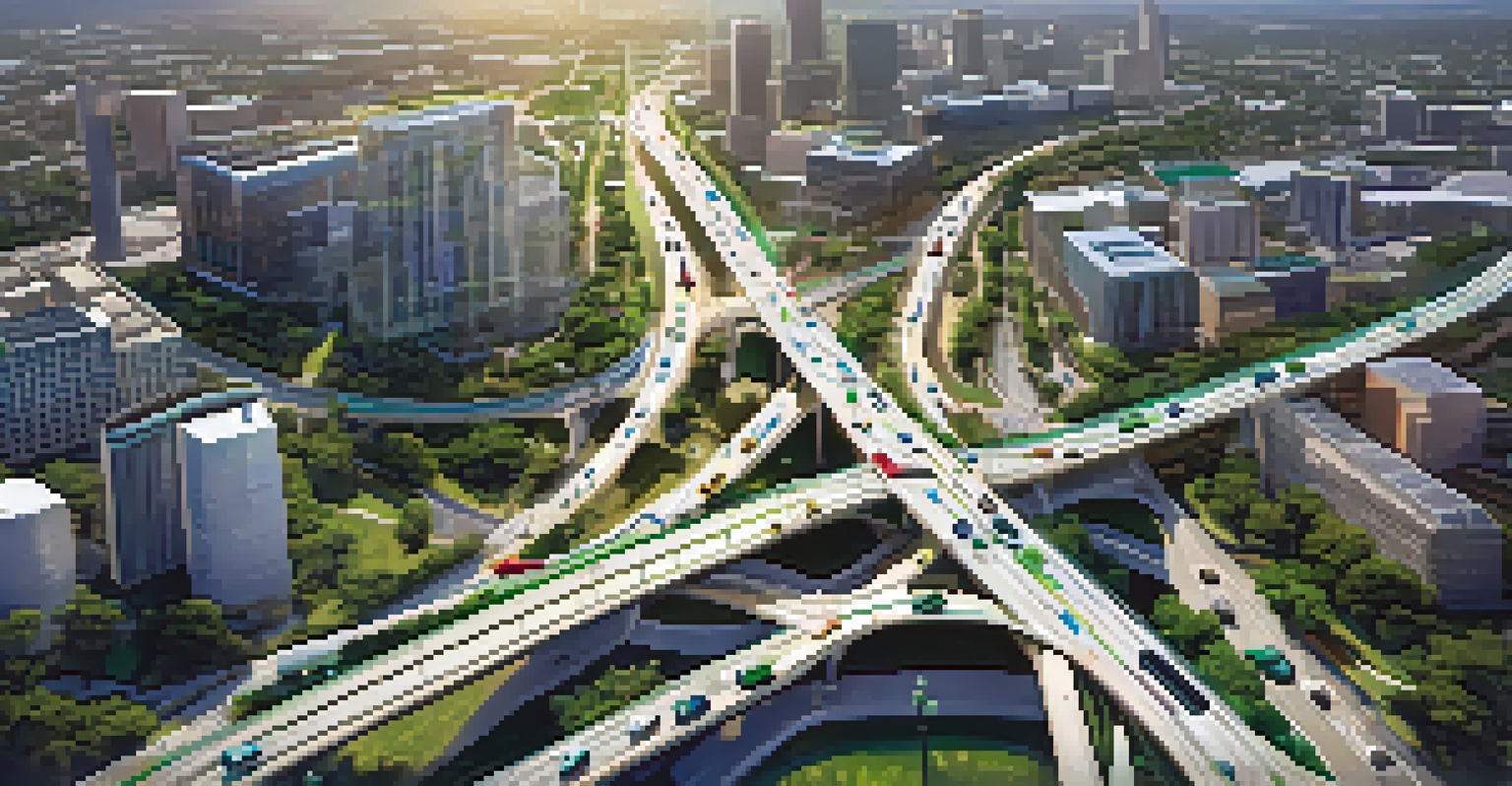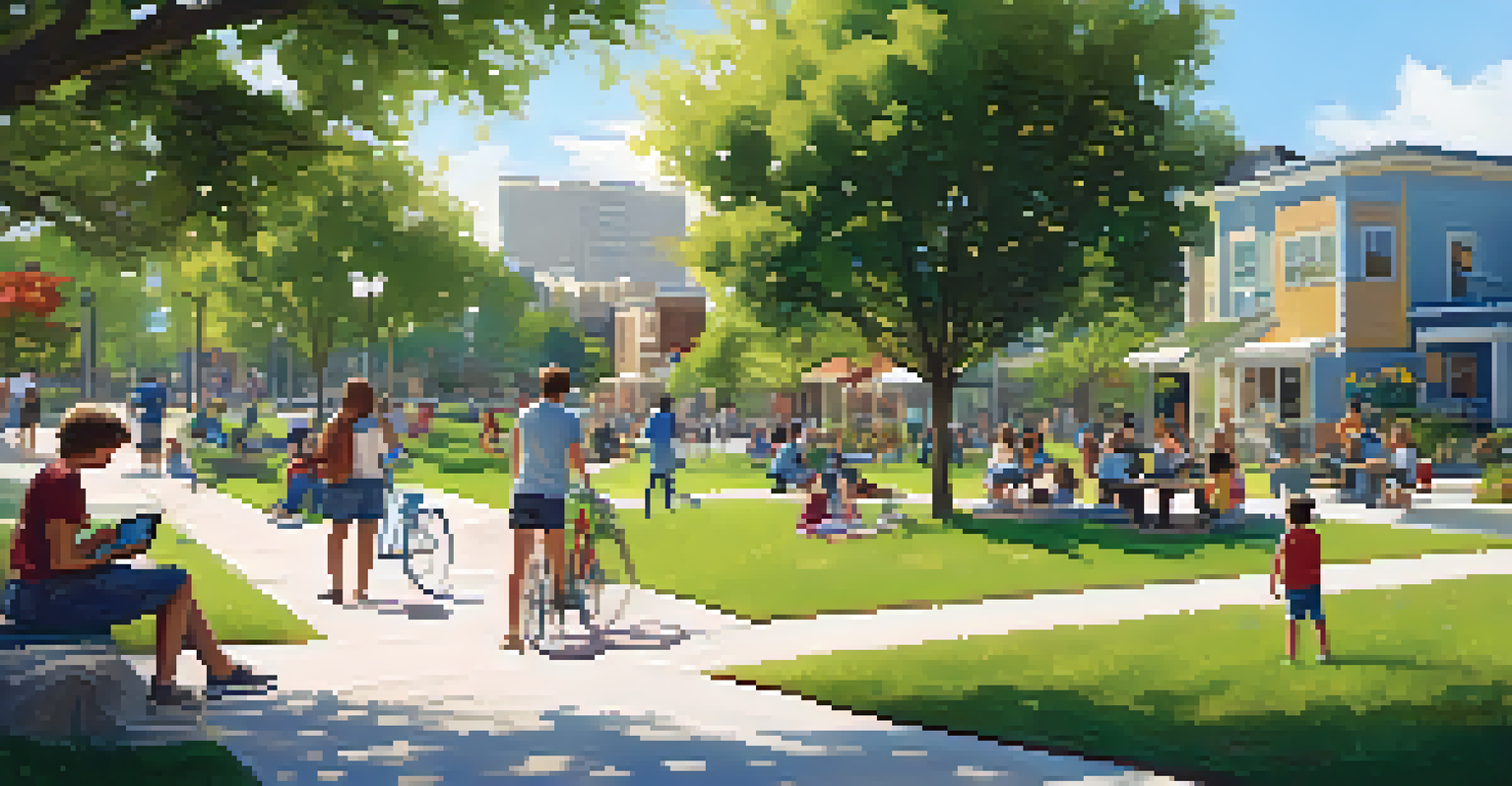Smart City Initiatives and Austin's Urban Future

Introduction to Smart City Concepts and Austin's Vision
Smart cities incorporate technology to enhance urban living, making cities more efficient and sustainable. Austin, known for its vibrant culture and tech-savvy population, is embracing this trend to improve the quality of life for its residents. The city’s vision includes integrating smart technologies into transportation, energy, and public services, aiming to create a more connected and resilient urban environment.
The future will be shaped by the cities we build and the technologies we embrace.
As Austin grows, so do the challenges it faces, such as traffic congestion and resource management. Smart city initiatives aim to tackle these issues by utilizing data-driven solutions that enhance decision-making. For instance, real-time traffic data can optimize traffic signals, reducing delays and emissions, ultimately leading to a more efficient transportation network.
Moreover, community engagement is at the heart of Austin's smart city strategy. By involving residents in the planning process, the city ensures that innovations meet the actual needs of its citizens. This collaborative approach fosters a sense of ownership and encourages participation in the development of a sustainable urban future.
Austin's Transportation Innovations for a Smarter City
Transportation is a key focus of Austin's smart city initiatives, with innovative projects aimed at reducing congestion and improving mobility. One example is the implementation of smart traffic management systems, which use data analytics to adjust traffic signals in real time based on current road conditions. This not only eases traffic flow but also enhances safety for both drivers and pedestrians.

Additionally, Austin is investing in public transportation enhancements, such as the expansion of bus routes and the integration of mobile apps that provide real-time updates. These tools make it easier for residents to navigate the public transit system, encouraging more people to choose public transport over personal vehicles. As a result, this shift can lead to decreased traffic and lower carbon emissions.
Smart Transportation Innovations
Austin is enhancing mobility with smart traffic management systems and expanded public transport options.
Biking is another priority, with the city developing dedicated bike lanes and bike-sharing programs. These initiatives promote a healthier lifestyle while also providing an eco-friendly alternative to traditional commuting. By fostering a culture of cycling, Austin not only enhances mobility options but also contributes to a cleaner, greener environment.
Sustainable Energy Solutions in Austin's Smart City Approach
Austin is at the forefront of sustainable energy initiatives, incorporating smart technologies to manage energy consumption effectively. The city has embraced renewable energy sources, such as solar and wind, to power its infrastructure and reduce reliance on fossil fuels. Smart grids and energy management systems help optimize energy distribution, ensuring efficiency and reliability.
Technology is best when it brings people together.
One notable project is the development of community solar programs, which allow residents to invest in solar energy without needing to install panels on their homes. This approach democratizes access to clean energy, making it more affordable and accessible for everyone. It’s a win-win, as residents save on energy costs while contributing to the city’s environmental goals.
Moreover, Austin encourages energy efficiency through smart home technologies that allow homeowners to monitor and control their energy usage remotely. By offering incentives for energy-efficient appliances and smart thermostats, the city promotes sustainable living practices that not only benefit the environment but also reduce utility bills.
Enhancing Public Safety with Smart Technologies
Public safety is a critical aspect of Austin's smart city initiatives, leveraging technology to create safer neighborhoods. The city is implementing smart surveillance systems that utilize AI and data analytics to monitor crime patterns and enhance law enforcement responsiveness. These systems can provide real-time alerts, enabling quicker responses to incidents.
In addition to surveillance, Austin's emergency services are adopting technology to improve communication and coordination during crises. For example, a centralized data platform allows first responders to access vital information swiftly, ensuring that they can make informed decisions in critical situations. This integration of technology ultimately enhances community safety and resilience.
Sustainable Energy Initiatives
The city is leading in renewable energy solutions and smart technologies to promote efficiency and reduce costs.
Furthermore, the city is fostering community-policing initiatives that encourage strong relationships between residents and law enforcement. By incorporating feedback and utilizing technology to report concerns, Austin is working towards a proactive approach to public safety that prioritizes community engagement and trust.
Smart Waste Management Solutions in Austin
Waste management is another area where Austin is harnessing smart technology to promote sustainability. The city has introduced smart waste bins equipped with sensors that signal when they are full, optimizing collection routes and reducing fuel consumption for waste collection trucks. This innovative approach not only saves resources but also minimizes the environmental impact of waste disposal.
Additionally, Austin is promoting recycling and composting through educational campaigns and accessible facilities. By integrating smart technology into waste management, the city can better track recycling rates and identify areas for improvement. This data-driven approach ensures that waste diversion strategies are effective and adaptable to changing community needs.
Moreover, community involvement is crucial in these initiatives. By encouraging residents to participate in recycling programs through app-based tracking and rewards, Austin fosters a culture of sustainability. This collective effort not only helps manage waste effectively but also strengthens the community’s commitment to environmental stewardship.
Digital Equity and Access in Austin's Smart City Future
As Austin embraces smart city initiatives, ensuring digital equity is vital for the success of these projects. The city recognizes that not all residents have equal access to technology, which can create disparities in utilizing smart services. Efforts are being made to bridge this digital divide by expanding broadband access in underserved areas, enabling all residents to benefit from the advancements.
Programs aimed at providing affordable internet access and digital literacy training are essential components of Austin's strategy. By equipping residents with the necessary skills to navigate technology, the city empowers them to engage with smart services. This inclusivity ensures that everyone can participate in shaping Austin’s urban future.
Community Engagement is Key
Austin prioritizes community involvement to ensure smart city initiatives meet the needs of all residents.
Moreover, community partnerships with local organizations play a significant role in promoting digital equity. Collaborative efforts to provide resources and support for vulnerable populations help foster a more connected and engaged community. By prioritizing digital inclusion, Austin is paving the way for a smarter, more equitable city for all.
Community Engagement in Austin's Smart City Initiatives
Community engagement is the backbone of Austin's smart city initiatives, ensuring that residents have a voice in shaping their urban environment. The city actively seeks input from citizens through public forums, surveys, and collaborative workshops. This participatory approach fosters transparency and builds trust between the city government and its residents.
Furthermore, technology plays a vital role in facilitating this engagement. Mobile apps and online platforms allow residents to provide feedback, report issues, and stay informed about ongoing projects. This accessibility not only empowers citizens but also streamlines communication between the city and its inhabitants.

Austin's commitment to community engagement extends to partnerships with local organizations and advocacy groups. By working together, they can address specific community needs and create tailored solutions. This collaborative spirit ensures that smart city initiatives are not only technologically advanced but also grounded in the realities of the people they serve.